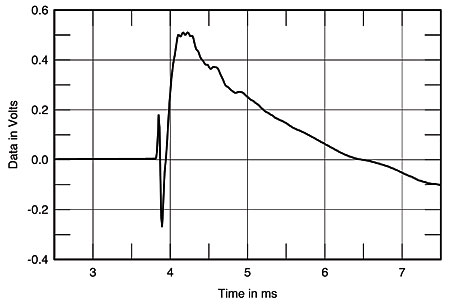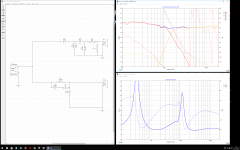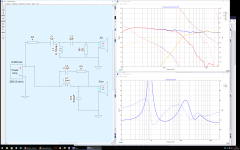- is phase coherency really important in a speaker ?
Jury is still out. The growing FR segment of the market might be an indicator that it is (no XO). But so much has to do with the nature of your hearing, and how phase coherent the media is.
- is a powered speaker coherent by design ?
No. They are usually just as bad as most speakers.
dave
hi thanks a lot for the very kind and helpful advice
First of all please let me explain a little the origin of my doubts
I was listening to the old cd test depicted here below
:format(jpeg):mode_rgb():quality(40)/discogs-images/R-5988794-1488484175-3931.jpeg.jpg)
there is a test voice track with a signal first in phase and then out of phase
When in phase the voice is dead center .. when out of phase the voice is difficult to locate in space not focused
I guess that when the effect is very strong the speakers should be more phase coherent ? because they allow to discriminate better the situation in phase from out of phase ?
leaving aside xover less speakers which would be an example of multi-ways phase-coherent speaker?
Maybe this one is almost phase coherent ?
https://www.stereophile.com/images/archivesart/1107DC1fig8.jpg

as you can understand i am as much confused as intrigued
For me 3D soundstage is everything
First of all please let me explain a little the origin of my doubts
I was listening to the old cd test depicted here below
:format(jpeg):mode_rgb():quality(40)/discogs-images/R-5988794-1488484175-3931.jpeg.jpg)
there is a test voice track with a signal first in phase and then out of phase
When in phase the voice is dead center .. when out of phase the voice is difficult to locate in space not focused
I guess that when the effect is very strong the speakers should be more phase coherent ? because they allow to discriminate better the situation in phase from out of phase ?
leaving aside xover less speakers which would be an example of multi-ways phase-coherent speaker?
Maybe this one is almost phase coherent ?
https://www.stereophile.com/images/archivesart/1107DC1fig8.jpg

as you can understand i am as much confused as intrigued
For me 3D soundstage is everything
Last edited:
The effect of swapping phase on one channel would be clear even with really bad speakers. All it requires is that the two speakers are identical, not that they are good.
May you are confusing interchannel phase problems with frequency-dependent phase problems?
Hi and yes probably i am confusing things because phase is a very difficult concept for me to understand. I can understand freq response, distortion, dispersion but phase i do not understand.
But let's take a full range single driver no xover speaker as an example of 100% phase coherent speaker.
I have listened to some of the kind like the Quad esl 63 and Magneplanar ... do they really provide a "coherence" in sound that is very difficult to achieve instead with a standard multiways speaker or it is just a sensation ?
I mean there must be some reasons why wideband drivers have become so popular lately. I know that they have limits in freq range, dispersion and distortion ... but what i could get in return ? what are their peculiar characteristics that are impossible to match with a more traditional design ? are they the way to go ?
My ideal speaker has a fantastic 3D soundstage and great voice reproduction. That is what i am looking for.
Last edited:
...there is a test voice track with a signal first in phase and then out of phase
When in phase the voice is dead center .. when out of phase the voice is difficult to locate in space not focused
I guess that when the effect is very strong the speakers should be more phase coherent ? because they allow to discriminate better the situation in phase from out of phase ?
i would guess that that track shows you whether 1 speaker is out of phase with the other, nothing to do with the phase performance of the speaker.
Having the speakers connected in the same phase is very important.
dave
… let's take a full range single driver no xover speaker as an example of 100% phase coherent speaker.
I have listened to some of the kind like the Quad esl 63 and Magneplanar …
Not good examples, each of those is a 2-way.
dave
Planet said it first, but I think you are confusing two terms. IN a stereo setup, the two speakers need to be in phase with each other, meaning they move forward or back at the same time. When you ask if a speaker is phase coherent, what we generally mean is within one speaker, are the drivers (woofer, tweeter) lined up in the box so the sound wavefronts from all drivers arrive at the listener together. In other words, if the tweeter is four inches closer to the listener than the woofer is, the sound from each arrives slightly different in time.
SO your single driver speaker would be phase coherent only in the sense that all the frequencies come from the same driver The single driver box could be wired in or out of phase with its mate, but that is separate.
Any speaker will reveal phasing if you reverse the wires to ONE side of the pair.
Within a multi-driver cabinet, it is also important for all the drivers to be in phase with one another. That is not the same as phase coherent. By their nature, crossover circuits can alter the phase of a signal, so it often is not as simple as wiring all the + terminals together.
Your description was classic. In phase speakers make the sound seem to come from the center between the speakers. Out of phase speakers make the sound seem to come from somewhere around you. Also out of phase tends to cancel the bottom end substantially.
SO your single driver speaker would be phase coherent only in the sense that all the frequencies come from the same driver The single driver box could be wired in or out of phase with its mate, but that is separate.
Any speaker will reveal phasing if you reverse the wires to ONE side of the pair.
Within a multi-driver cabinet, it is also important for all the drivers to be in phase with one another. That is not the same as phase coherent. By their nature, crossover circuits can alter the phase of a signal, so it often is not as simple as wiring all the + terminals together.
Your description was classic. In phase speakers make the sound seem to come from the center between the speakers. Out of phase speakers make the sound seem to come from somewhere around you. Also out of phase tends to cancel the bottom end substantially.
Planet said it first, but I think you are confusing two terms.
IN a stereo setup, the two speakers need to be in phase with each other, meaning they move forward or back at the same time.
Hi ! that is clear to me. Red with red and black with black always.
I had an old pair of speakers without the red and black marks. Then a friend told me to check with a 1.5V battery ... when the + of the battery and of the speaker are connected the woofer comes forward.
When you ask if a speaker is phase coherent, what we generally mean is within one speaker, are the drivers (woofer, tweeter) lined up in the box so the sound wavefronts from all drivers arrive at the listener together. In other words, if the tweeter is four inches closer to the listener than the woofer is, the sound from each arrives slightly different in time. SO your single driver speaker would be phase coherent only in the sense that all the frequencies come from the same driver The single driver box could be wired in or out of phase with its mate, but that is separate.
Ok i understand. But this i would call time coherence ? i have seen many speakers with drivers mounted in a way that the center of emissions of the different drivers are on a same plane like the old B6W dm6 and many others.
Any speaker will reveal phasing if you reverse the wires to ONE side of the pair.
Within a multi-driver cabinet, it is also important for all the drivers to be in phase with one another. That is not the same as phase coherent. By their nature, crossover circuits can alter the phase of a signal, so it often is not as simple as wiring all the + terminals together.
Your description was classic. In phase speakers make the sound seem to come from the center between the speakers. Out of phase speakers make the sound seem to come from somewhere around you. Also out of phase tends to cancel the bottom end substantially.
Thank you very much indeed. I think i have identified better the problem with your help.
I should have asked about phase coherent crossovers ?
is there any link treating this precise topic ?
And i also wonder if active xovers are easier to me built phase coherent than passive ones.
Actually i do not understand why not all commercial crossovers are phase coherent ... is it so difficult to design one ?
Thanks a lot again,
Kind regards
Last edited:
I don't think phase is your issue.My ideal speaker has a fantastic 3D soundstage and great voice reproduction. That is what i am looking for.
I don't think phase is your issue.
Hi ! i agree that the listening room comes first ... but i understand speakers come second in order to get great soundstage (assuming that the soundstage has been well captured in the recordings of course). Let's say that if there is in the recording i would like to get it.
Moreover i have the feeling that to design a phase coherent crossover is quite challenging. Just a feeling.
That they are more the exception than the rule ?
This could be the reason why many audio lovers prefer wideband single drivers ?
and despite of all their other limits
There are some ways to build transient-perfect (=phase-coherent) or at least transient-improved crossovers that can't be done easily in a passive way.
I once did a quite simple active crossover for a wideband Driver plus woofer topology which is not that difficult to implement and that is almost transient perfect. For ages I wanted to do that one again with cheaper drivers buit I didn't find any time for it so far.
Regards
Charles
I once did a quite simple active crossover for a wideband Driver plus woofer topology which is not that difficult to implement and that is almost transient perfect. For ages I wanted to do that one again with cheaper drivers buit I didn't find any time for it so far.
Regards
Charles
Moreover i have the feeling that to design a phase coherent crossover is quite challenging. Just a feeling.
That they are more the exception than the rule ?
This could be the reason why many audio lovers prefer wideband single drivers ?
and despite of all their other limits
It's not particularly challenging to design a phase coherent speaker on one axis.
The moment you throw in a real room with different arrival times for the same frequencies, that you begin to face a problem.
For any two driver combination excepting coaxials and horns, actually being phase coherent at listening position in a real room is quite difficult, regardless of performance in anechoic conditions.
Single driver speakers are not immune to room issues either so suffer from phase errors in real world situations anyway.
leaving aside xover less speakers which would be an example of multi-ways phase-coherent speaker?
This is a random but very telling example (of a phase coherent passive, non-DSP multi-way system)
Vandersteen Audio Treo loudspeaker Measurements | Stereophile.com
Leaving aside the discussion wether transient-perfect is needed at all, there is always the discussion about loosing transient-accuracy off axis. I would say that if it matters at all it will definitely only matter on axis anyway, because only the first wavefront is used to localise a sound source by our auditory system.
OTOH I agree that some methods used for achieving transient-improved
response are detrimental to the off-axis amplitide response. How much that matters depends on the actual listening situation.
Regards
Charles
OTOH I agree that some methods used for achieving transient-improved
response are detrimental to the off-axis amplitide response. How much that matters depends on the actual listening situation.
Regards
Charles
I'll try and illustrate using a theoretical simulation. I do not like the construction complexity of tilted or stepped baffles. When I desire time alignment I will put tweeter below woofer or 'fix it' in the crossover.
I have attached two pictures, each is for a 'phase coherent' system with drivers tracking phase reasonably well (for a multi-driver system on a flat baffle). All FRD/ZMA files were traced from manufacturer's IB measurements, and the bump at the low end is to compensate for baffle step. Both driver sets are totally different, and time offsets have been manually entered.
In picture 1, notice the two drivers track phase very accurately right upto the point the the woofer starts going crazy due to breakup. Though in FR terms it is contributing very little to the output, this is not going be winning any awards for good performance. It will be a little rough up top.
In picture 2, you will see the drivers tracking much better all the way till 40-45dB of attenuation, with very little phase difference till we get past 9k. This will be a better product (provided drivers have low distortion etc and if I manage to get the time to actually finish the crossover and buy parts).
IOW, phase coherence alone does not make a speaker sound good.
I have attached two pictures, each is for a 'phase coherent' system with drivers tracking phase reasonably well (for a multi-driver system on a flat baffle). All FRD/ZMA files were traced from manufacturer's IB measurements, and the bump at the low end is to compensate for baffle step. Both driver sets are totally different, and time offsets have been manually entered.
In picture 1, notice the two drivers track phase very accurately right upto the point the the woofer starts going crazy due to breakup. Though in FR terms it is contributing very little to the output, this is not going be winning any awards for good performance. It will be a little rough up top.
In picture 2, you will see the drivers tracking much better all the way till 40-45dB of attenuation, with very little phase difference till we get past 9k. This will be a better product (provided drivers have low distortion etc and if I manage to get the time to actually finish the crossover and buy parts).
IOW, phase coherence alone does not make a speaker sound good.
Attachments
Show me any driver with no phase variation. A crossover is not the only thing to change phase.But let's take a full range single driver no xover speaker as an example of 100% phase coherent speaker.
A crossover can even improve phase.
Show me any driver with no phase variation. A crossover is not the only thing to change phase.
A crossover can even improve phase.
QFT.
The assumption is that single drivers have 100% phase coherence.
The truth is that dynamic loudspeakers by their very design are not phase coherent devices. It is impossible to have any device/component that creates a delay between current and voltage to be 'phase perfect', if that were a thing.
Hi, adding to what others have said about the use, or rather miss-use, of the term phase often heard in home audio discussions...
'Polarity' is the preferred term for getting + and - in sync together.
If I may define a powered speaker as a multi-way, where each driver section is actively driven by a separate amplifier channel, then I would say any good design has been built to be phase coherent. It's silly not to.
In the prosound world, phase coherency has become a clearly stated objective, often ranking with frequency response, pattern control, and SPL.
Meyersound has stressed phase accuracy for well over 20 years. Today, every new design touts phase coherency...here's a couple of examples from yamaha and rcf ........ DZR / DXS XLF Series - DZR Features - Speakers - Professional Audio - Products - Yamaha - UK and Ireland
FiRPHASE - RCF
It's audible and can only help ime/imo, ...whether in a good room, a bad room, or outdoors (best place to evaluate)
'Polarity' is the preferred term for getting + and - in sync together.
If I may define a powered speaker as a multi-way, where each driver section is actively driven by a separate amplifier channel, then I would say any good design has been built to be phase coherent. It's silly not to.
In the prosound world, phase coherency has become a clearly stated objective, often ranking with frequency response, pattern control, and SPL.
Meyersound has stressed phase accuracy for well over 20 years. Today, every new design touts phase coherency...here's a couple of examples from yamaha and rcf ........ DZR / DXS XLF Series - DZR Features - Speakers - Professional Audio - Products - Yamaha - UK and Ireland
FiRPHASE - RCF
It's audible and can only help ime/imo, ...whether in a good room, a bad room, or outdoors (best place to evaluate)
- Status
- This old topic is closed. If you want to reopen this topic, contact a moderator using the "Report Post" button.
- Home
- Loudspeakers
- Multi-Way
- Powered speakers _ are they phase coherent by design ?

